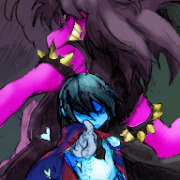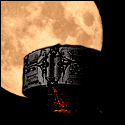|
Because I'm bad at typing AND proof-reading.... Time to fix that. EDIT:  Printer Friendly. Moriatti fucked around with this message at 03:14 on May 28, 2017 |
|
|
|

|
| # ? May 26, 2024 11:33 |
|
Moriatti posted:Because I'm bad at typing AND proof-reading.... Time to fix that. Looks kinda like that combat roll table is missing an icon to represent damage. Also it should maybe say under Action Points that you need a "Related Skill" to gain advantage on a skill roll.
|
|
|
|
I actually... can't believe I missed that, I'll fix it when I get home tonight. I probably will not change that action line for the same reason that I don't have the skill table: I feel like the skill rules are narrative and loose enough for the GM, or, me in this instance, to clarify that and it not completely big the game down like not knowing what a standard action is.
|
|
|
|
For the Summoner's at-will powers, particularly the Scout, do they need an enemy to use them against? Would there be balance problems if they were allowed to use the power in any empty space?
|
|
|
|
Aston posted:For the Summoner's at-will powers, particularly the Scout, do they need an enemy to use them against? Would there be balance problems if they were allowed to use the power in any empty space? They'd lose out on an attack to do so, so I think it's probably fine to allow it. That's downside enough.
|
|
|
|
So for Ongoing Damage, I'm assuming it only applies once per round to Champions and Bloodied Elites, who take multiple turns? The wording is unclear. Thus far, I've played it such that monsters with multiple turns suffer from detrimental round-long effects (such as Ongoing Damage) on their first turn, but gain from beneficial round-long effects (such as their traits) on each turn.
|
|
|
|
narelith posted:So for Ongoing Damage, I'm assuming it only applies once per round to Champions and Bloodied Elites, who take multiple turns? The wording is unclear. In one campaign I took part in, this issue came up as well. We basically settled for the same ruling as you did. The martial artists Supreme Scorpion Style prompted the discussion. It just seemed silly to have it be triple as strong against bosses. But I don't think it's a good general rule as you might make lvl 9 Poisoner Rogues or Magicians with Momentary Encystment sad. Kabbak fucked around with this message at 06:09 on May 31, 2017 |
|
|
|
Kabbak posted:In one campaign I took part in, this issue came up as well. We basically settled for the same ruling as you did. The martial artists Supreme Scorpion Style prompted the discussion. It just seemed silly to have it be triple as strong against bosses. Did you mean Tempest? Scorpion is ongoing damage, and is weak vs Champions since they auto save. Tempest is damage when starting adjacent, and I would not rule against applying it every turn. Champions and Elites are essentially designed like multiple foes in one body. It makes perfect sense for a power that would affect multiple enemies each round to also effect a Champion or Elite multiple times.
|
|
|
|
eth0.n posted:Did you mean Tempest? Scorpion is ongoing damage, and is weak vs Champions since they auto save. The Supreme Scorpion Style (highest tier of stance) deals Ongoing until the end of the encounter (no save). I would argue that Tempest is covered by the "Damaging Zones" section on p.94 and can't trigger several turns per round for the same creature. (Some of this section isn't included in the glossary entry for zones so it's easily overlooked.) Kabbak fucked around with this message at 07:18 on May 31, 2017 |
|
|
|
Kabbak posted:The Supreme Scorpion Style (highest tier of stance) deals Ongoing until the end of the encounter (no save). Oh, right, ongoing until end of encounter is very powerful vs Champions. They should probably have an ability to shake off "until end of encounter" effects, since those usually shouldn't affect the 3 or 4 enemies they represent from one encounter power. Probably just have them make normal saves against such effects. For Tempest, I disagree with that interpretation. That section only says "move adjacent", not "start turn". That makes sense, since the former is easily exploited if this rule exists; the latter can't be, since there's no way for a player to force an enemy to take extra turns. But it's unclear what "wording such as" is meant to imply. I interpret it as only referring to movement.
|
|
|
|
eth0.n posted:Oh, right, ongoing until end of encounter is very powerful vs Champions. They should probably have an ability to shake off "until end of encounter" effects, since those usually shouldn't affect the 3 or 4 enemies they represent from one encounter power. Probably just have them make normal saves against such effects. Yes you are right. This is unclear. I disagree wether it should work or not but at the same time I don't think it's a big deal to rule either way.
|
|
|
|
It seems straightforward to me that Tempest creates a zone that can only damage a target once per round by the page 94 rules. It seems wrong to read a detail of the example (that movement is involved) into the rule itself when the rule explicitly states that "it is broad and any exceptions must be specifically called out." From a game balance perspective it's not unreasonable for the monster to take damage multiple times a round, but we only need to worry about that sort of intent if the language itself is unclear. Further, if we want to consider the intent of the rule, Strike is narrative first, and it's not any more damaging to stand adjacent to a fire just because you're hyperactive and do a lot of stuff each round.
|
|
|
|
"narrative first" just sounds like a storygamer version of "natural language"
|
|
|
|
Tuxedo Catfish posted:"narrative first" just sounds like a storygamer version of "natural language" How so?
|
|
|
|
Sir Kodiak posted:How so? In the sense that they're both offered as ways to consistently resolve ambiguities, but don't actually provide consistency at all. The flip side of course is that a) technical writing is hard, especially if you don't want it to be MTG Comprehensive Rules-sized, and b) at some point you're probably going to have to leave some things up to DM judgment, it's just a question of when.
|
|
|
|
Tuxedo Catfish posted:In the sense that they're both offered as ways to consistently resolve ambiguities, but don't actually provide consistency at all. Narrative first means that a particular rule might or might not be applicable depending on non-rule (i.e., narrative) concerns. It introduces inconsistency and ambiguity. It's not a way to resolve it.
|
|
|
|
Sir Kodiak posted:Narrative first means that a particular rule might or might not be applicable depending on non-rule (i.e., narrative) concerns. It introduces inconsistency and ambiguity. It's not a way to resolve it. "It's fire, therefore it works like this, instead of that" is a way of resolving an ambiguity in the rules as rules. You wouldn't let a player rewrite the unambiguous rules text of an ability just because they reskinned it, so there isn't actually any new ambiguity introduced. (I mean, maybe you would, but eww.)
|
|
|
|
Ugh my PC breaks just when I decide to get off my rear end and start work on the DANMAKUMANCER
|
|
|
|
Tuxedo Catfish posted:"It's fire, therefore it works like this, instead of that" is a way of resolving an ambiguity in the rules as rules. You wouldn't let a player rewrite the unambiguous rules text of an ability just because they reskinned it, so there isn't actually any new ambiguity introduced. "Reskinning is the idea that you can use the mechanics as written but change your narration of how those mechanics are enacted... You as a player are free to determine what exactly your character is doing when you use the powers provided by your Class." (page 98) "When any player, including the GM, uses a power or creates any sort of mechanical effect, it’s incumbent on them to explain and describe what their character just did. Sometimes this description conflicts with what the mechanics prescribe. The rule here is that the fiction takes precedence... Hey, doesn’t it make sense that my flaming arrow would set off those powder kegs? Why yes, it does—so they explode and do... whatever they do in that situation." (page 91) So, yes. Reskinning changes what a character is doing when they use a power. What a character is doing when they used a power can restrict or expand what that power does. That's the plain text of the rules.
|
|
|
|
If the ability text says "deal 3 damage," then however you reskin it doesn't matter. It does 3 damage. There's no reason to refer to the narrative in the first place unless it's not clear what the ability does. Improvised attacks are a separate issue from "how do I interpret the rules text" which is what "narrative first" is doing if you use it to determine that waving someone through a fire does or does not deal extra damage (and the rules aren't already clear.) Tuxedo Catfish fucked around with this message at 00:34 on Jun 1, 2017 |
|
|
|
More significantly, it's kind of a bad way to resolve the actual issue, which is that getting tons of free damage off a combination of forced movement and fields is game-warpingly powerful and should be handled as a balance problem. Even if I find some way to narratively justify a power that's more dangerous on intermittent exposure vs. constant exposure, that's still the case.
|
|
|
|
Kabbak posted:In one campaign I took part in, this issue came up as well. We basically settled for the same ruling as you did. The martial artists Supreme Scorpion Style prompted the discussion. It just seemed silly to have it be triple as strong against bosses. Yeah, Encystment is different because it's until the user's next turn. One of my players used it against Champions quite effectively -- though she later decided that it gave the party too much downtime by which to wait for the boss to reappear. As for Poisoner Rogues, I think getting to potentially stack the damage of the effect is very strong, certainly comparable to Supreme Scorpion Style. That said, if I had one in my party I'd probably rule that if the Champion only suffers the effect once, they only get to save once, too.
|
|
|
|
Tuxedo Catfish posted:If the ability text says "deal 3 damage," then however you reskin it doesn't matter. It does 3 damage. There's no reason to refer to the narrative in the first place unless it's not clear what the ability does. My second quote was from the "Fiction Takes Precedence" section, which is about all powers, not just improved attacks. And monsters can have stuff like Vulnerable 1 (fire), which keys entirely off how powers are skinned, not something in the mechanics. This is discussed on page 140: "It can be useful to give attacks (both the players’ and their enemies’) keywords, like “Loud” or “Explosive” or “Fire” for the purposes of figuring out what sorts of effects they have outside of the listed mechanical effects. A “Loud” attack attracts attention, an “Explosive” one destroys or reduces enemy cover but may also destroy valuable items, an attack with the “Fire” keyword sets the dry forest alight where the same power with a different flavor would not, and an attack with the “Psychic” keyword cannot work at all against a mindless machine. These keywords depend entirely on the trappings the players and GM assign to their powers and not at all on the actual mechanics. It’s important to give these trappings actual in-game effects so that players know that they can use these same abilities out of combat or in creative ways in combat, and keywords can help with that." (emphasis mine) Tuxedo Catfish posted:More significantly, it's kind of a bad way to resolve the actual issue, which is that getting tons of free damage off a combination of forced movement and fields is game-warpingly powerful and should be handled as a balance problem. Even if I find some way to narratively justify a power that's more dangerous on intermittent exposure vs. constant exposure, that's still the case. Well then it's fortunate that my interpretation of the rules was based entirely on the text of the rules.
|
|
|
|
narelith posted:As for Poisoner Rogues, I think getting to potentially stack the damage of the effect is very strong, certainly comparable to Supreme Scorpion Style. That said, if I had one in my party I'd probably rule that if the Champion only suffers the effect once, they only get to save once, too. narelith posted:Yeah, Encystment is different because it's until the user's next turn. One of my players used it against Champions quite effectively -- though she later decided that it gave the party too much downtime by which to wait for the boss to reappear. The other players can prepare an attack for when the enemy reappears, so they don't lose their initiative spots. So it's similar to a 3-turn-stun against Champions. Speaking of preparing actions: How do you folks handle prepared actions and negative effects? For example, if you are "Immobilzed until the end of your turn" and theres nobody in range for your attacks, can you prepare a charge with the trigger "when I'm no longer immobilized" (or any other trigger after your turn). Most of the time my groups handle it with the rule for delaying: if it's negative you still suffer it until your action goes off. For an ability like Encystment though, this becomes difficult. You probably shouldn't be able to prolong it but taking your action afterwards feels like cheating the design intend of the power (enemy reappears at the "end of your next turn"). Or if you are the ally of the Magician the "negative effect" (enemy untargetable) is based on an other players turn. I'm not sure how to handle this best.
|
|
|
|
Kabbak posted:Yeah that sounds good. Then it won't be less damage, it just takes normally long to apply (and isn't tripple as fast). This is why I think prepared/delayed actions are kind of bad. I understand the intent behind their inclusion but the only time people really use them is to screw with action economy. If you want to shoot a guy as soon as he comes around a corner, you should just shoot him on your turn.
|
|
|
|
Sir Kodiak posted:Well then it's fortunate that my interpretation of the rules was based entirely on the text of the rules. Sir Kodiak posted:Further, if we want to consider the intent of the rule, Strike is narrative first, and it's not any more damaging to stand adjacent to a fire just because you're hyperactive and do a lot of stuff each round. Tuxedo Catfish fucked around with this message at 01:58 on Jun 1, 2017 |
|
|
|
Sir Kodiak posted:My second quote was from the "Fiction Takes Precedence" section, which is about all powers, not just improved attacks. Monsters can do all of these things, but that's not's what happening when you refer to "narrative first" to resolve an ambiguity in field / forced movement interaction.
|
|
|
|
Yeah, I figured you'd bring that up. As is clear in context, that was a side comment on how Strike works if we care about the question of intent. The basis for my interpretation is in the first paragraph, which you cut out:Sir Kodiak posted:It seems straightforward to me that Tempest creates a zone that can only damage a target once per round by the page 94 rules. It seems wrong to read a detail of the example (that movement is involved) into the rule itself when the rule explicitly states that "it is broad and any exceptions must be specifically called out." Tuxedo Catfish posted:Monsters can do all of these things, but that's not's what happening when you refer to "narrative first" to resolve an ambiguity in field / forced movement interaction. I'm not using narrative first to resolve an ambiguity. As I said in my post, there's no ambiguity: it's clear as written. Sir Kodiak fucked around with this message at 02:09 on Jun 1, 2017 |
|
|
|
Even if this specific case isn't resolved that way, I'm still taking issue with your theoretical. v
|
|
|
|
Tuxedo Catfish posted:Even if this specific case isn't resolved that way, I'm still taking issue with your theoretical. v Going over the discussion again, I think I better understand your issue, so I'll rephrase. To be clear, I'm not saying that we should resolve rule ambiguities based on what makes more narrative sense. "Narrative first" is a high-level rule, like Rule Zero, that overrides other rules. It's not a method for resolving ambiguities. I brought up Strike's strong interest in narrative to make the point that even if the rule were ambiguous, we shouldn't assume the intent of the rules, even in Tactical Combat, is to create the most precisely balanced board game. It is totally appropriate for a GM to adjudicate their game based on maintaining balance, and even to house rule where there seems to be issues with the interaction between various rules (as with Champions getting wrecked by Supreme Scorpion Style). But I consider adjudication to be different than understanding the intent of a piece of writing. And if we want to get into the intent of the rules, we should be aware that Strike is built with as strong a concern for a consistent narrative as for balanced combat, so we shouldn't assume that all the rules are built to provide the latter.
|
|
|
|
megane posted:This is why I think prepared/delayed actions are kind of bad. I understand the intent behind their inclusion but the only time people really use them is to screw with action economy. If you want to shoot a guy as soon as he comes around a corner, you should just shoot him on your turn. Well, I've seen prepared actions used often. Mostly if two players want to setup a flank together. Then they can both get value out of it. Or if a setup power like "Reveal Weakness" from the Leader is used, some players in a bad initiative spot (after monster and before the leader) can get use out of it by preparing beforehand. But since it ends on the Monsters turn there is no way to "double tap" it (except somebody screws with initiative but that doesn't need prep. actions and is beside the point; Limber Leader Rogue GOGO!  ). ).So far I've found Encystment to be the odd one out. Now that I think about it, you can even use stuff like Reveal Weakness twice with Encystment and prepared actions ... So it's probably healthy to just say: "Folks, don't prepare actions with Encystment. Just use it to heal and setup positions and occasionally break stuff like Grab". Against multiple Monsters it's still almost a stun (just hinders focused fire a bit). But I think it would be a loss to drop prepared actions completely since I've seen plenty of use cases which were just fine.
|
|
|
|
Sir Kodiak posted:Going over the discussion again, I think I better understand your issue, so I'll rephrase. I think "narrative first" is primarily about encouraging thought about narrative during tactical combat, not a real basis for making decisions on combat rules. Narrative can justify almost anything. For example, should a Champion take damage from a fire every turn? Depends on how we picture HP. A Champion has far more HP than a normal monster, so perhaps each "tick" of the fire represents less physical damage, and if the Champion really does stay in the heat all three turns, they're narratively suffering about as much harm as a normal monster would in their one turn. I do view Strike's tactical combat as attempting to produce a precisely balanced board game. I think that's the correct approach for this kind of game. Certainly, the GM is empowered to tweak mechanics situationally to serve the narrative (this is how I view resistance/vulnerability to damage types, for example), but ideally, the published game should be as balanced and fully defined as possible. Essentially, narrative shouldn't justify rules, only balance should do that, but it can justify situational rulings at the table. As far as the rules for Tempest, I do now think it would only be 1 per round, because a similar power worded as a Zone clearly would be, and that would be arbitrarily inconsistent. However, I do think it and other Zones should apply every Champion turn, and those Zones rule should be clarified accordingly. These powers generally give a monster some way to avoid the damage (unlike Supreme Scorpion); a way to exert soft control. As-is, this soft control seems mostly toothless. That this avoidable damage is so limited, but ongoing-until-end-of-encounter clearly isn't, I view as a flaw in the game as-written. eth0.n fucked around with this message at 03:18 on Jun 1, 2017 |
|
|
|
eth0.n posted:I do view Strike's tactical combat as attempting to produce a precisely balanced board game. I think that's the correct approach for this kind of game. I think balance was a concern but not at the expense of other concerns. For example, take how some kits offer concrete combat benefits (e.g., The Seer giving "In Combat: you may use an extra Move Action or Role Action at the start of each combat before Initiative is rolled.") and others don't. Of course, that's one of the things I dislike about kits. eth0.n posted:However, I do think it and other Zones should apply every Champion turn, and those Zones rule should be clarified accordingly. These powers generally give a monster some way to avoid the damage (unlike Supreme Scorpion); a way to exert soft control. As-is, this soft control seems mostly toothless. That this avoidable damage is so limited, but ongoing-until-end-of-encounter clearly isn't, I view as a flaw in the game as-written. Yeah, agreed.
|
|
|
|
Sir Kodiak posted:I think balance was a concern but not at the expense of other concerns. For example, take how some kits offer concrete combat benefits (e.g., The Seer giving "In Combat: you may use an extra Move Action or Role Action at the start of each combat before Initiative is rolled.") and others don't. Pretty much, yeah. I basically leave kits out of the game unless I want to go to effort of making custom ones for the campaign setting.
|
|
|
|
Yeah, I just made a big table of spells and equipment and other out-of-combat powers instead of doing kits.
|
|
|
|
Had a few questions come up in our last session I was hoping you guys could help with. Do attacks that don’t require rolls provoke opportunities from Marks, particularly in the instance of the grappler’s Crush ability where he deals auto damage to grabbed targets? How do you deal with all your champion and elites being neutered by the controller role’s Sap Strength ability? Since it halves and rounds down, elites end up dealing the same damage as stooges with their at wills. Is there a better option than spamming distraction, daze, and stun onto the controller? In team conflicts, it suggests 2 different values for the opposition's base Advance and Defense scores. On Page 76 it suggests the oppositions score be equal to one less than the number of players but on page 79 it suggests it equal to the number of players. I realize its only a one score difference and it's suppose to vary beyond that already but which one is the default "fair" method?
|
|
|
|
Jack Fremont posted:Do attacks that don’t require rolls provoke opportunities from Marks, particularly in the instance of the grappler’s Crush ability where he deals auto damage to grabbed targets? Whether there's a roll or not is irrelevant. If the Crush doesn't target the marker, it provokes. quote:How do you deal with all your champion and elites being neutered by the controller role’s Sap Strength ability? Since it halves and rounds down, elites end up dealing the same damage as stooges with their at wills. Is there a better option than spamming distraction, daze, and stun onto the controller? You're only applying the weaken for a single turn, right? We've done a lot of Champions, and it hasn't seemed like our Controller has been exceptionally impactful. quote:In team conflicts, it suggests 2 different values for the opposition's base Advance and Defense scores. On Page 76 it suggests the oppositions score be equal to one less than the number of players but on page 79 it suggests it equal to the number of players. I realize its only a one score difference and it's suppose to vary beyond that already but which one is the default "fair" method? It should be number of players minus one. I suspect page 79 wasn't errata'd properly when the "intelligent opposition" rule (one less A & D, but pick one action like players do each round) became the default.
|
|
|
|
Yeah, given that a champion will only face one turn where they're weakened and then get two where they're not, it hasn't been something that I've felt it necessary to design combats around.
|
|
|
|
eth0.n posted:You're only applying the weaken for a single turn, right? We've done a lot of Champions, and it hasn't seemed like our Controller has been exceptionally impactful. Sir Kodiak posted:Yeah, given that a champion will only face one turn where they're weakened and then get two where they're not, it hasn't been something that I've felt it necessary to design combats around. Looking back it was probably my own fault and how I role played the fight. The elite had a leader feeding him extra attacks prior to the elite being bloodied, the leader got frustrated with the lack of results from the elite and began attacking on his own. After becoming bloodied the elite got boxed in and piled high with so many status effects that the weaken was only a part of the problem. Couple extra questions about the Evoker, granted I realize its a playtest class and I might not even have the most up to date version. Concerning the Darkness refined element. Its duration is until the target is effected by light (save ends). Does light have to specifically be the Light refined element or can an appropriate amount of light work, and if so what would an appropriate amount of light be? AoE save end blinds have been wrecking some of my encounters. I'm trying to understand the shockwave evocation better. It says to create a zone and attack each square within the zone. Does it attack squares if nothing is in it? Since its a zone does it linger and then attack anything coming into the zone? Thanks for the answers.
|
|
|
|

|
| # ? May 26, 2024 11:33 |
|
Jack Fremont posted:Concerning the Darkness refined element. Its duration is until the target is effected by light (save ends). Does light have to specifically be the Light refined element or can an appropriate amount of light work, and if so what would an appropriate amount of light be? AoE save end blinds have been wrecking some of my encounters. That's capital-L Light; the idea is that if you blind someone with Darkness, you want to hold off a followup Light blast because you'd wipe away your own debuff if you used it too early. If the Blind's too strong I can just change it to something less crippling (like "Has Disadvantage on all attacks and cannot take Opportunities", e.g. most of the Blinded status but without the part where you grant CA). It definitely shouldn't be so disruptive that you, the DM, are forced to set all your fights on the surface of the sun. Anyone else finding the Darkness element too strong? quote:I'm trying to understand the shockwave evocation better. It says to create a zone and attack each square within the zone. Does it attack squares if nothing is in it? Since its a zone does it linger and then attack anything coming into the zone? Shockwave is like Ray in that it frequently "attacks" a bunch of empty squares square purely for the purpose of creating terrain in those squares. For instance, a Water + Cold + Earth shockwave would allow you to draw a big patch of difficult terrain (representing frozen ground), even if there was only one creature inside it. I changed the capitalized "Zone" to a lowercase "area" to make it clear that the evocation itself wasn't creating some sort of repeatedly-damaging deathtrap. This is the most recent version of the Evoker, incidentally: https://docs.google.com/document/d/1JC3ZZCfSfIfiYVqA50saZ5YnNDWXwc-JJREHIbWE36g/pub
|
|
|

















